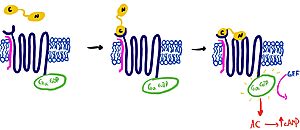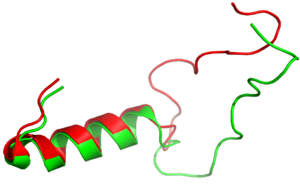Sandbox Ben Whiteside
From Proteopedia
(Difference between revisions)
| Line 1: | Line 1: | ||
==AMYR== | ==AMYR== | ||
<StructureSection load='7tyf' size='340' side='right' caption='AMYR Bound to Amylin' scene='10/1038828/Entire_protein_scene/4'> | <StructureSection load='7tyf' size='340' side='right' caption='AMYR Bound to Amylin' scene='10/1038828/Entire_protein_scene/4'> | ||
| - | This is a default text for your page '''Ben Whiteside'''. Click above on '''edit this page''' to modify. Be careful with the < and > signs. | ||
| - | You may include any references to papers as in: the use of JSmol in Proteopedia <ref>DOI 10.1002/ijch.201300024</ref> or to the article describing Jmol <ref>PMID:21638687</ref> to the rescue. | ||
==Introduction== | ==Introduction== | ||
When consuming food, the human body is tasked with secreting hormones and chemical messengers that will help regulate homeostasis. After a meal, our body has to maintain homeostasis by reducing our blood glucose and signaling that we have consumed enough nutrients. During feeding, cells in the body will secrete the ligand, amylin. [https://en.wikipedia.org/wiki/Amylin Amylin] is a 37 amino acid glucoregulatory hormone that is produced within [https://en.wikipedia.org/wiki/Beta_cell beta cells] of the pancreas. When there is an influx of nutrients in the gastrointestinal tract, the ligand will bind to the heterodimeric receptor, activating the receptor and triggering the corresponding signaling cascade. The overall effect of this cascade is increased satiety, delayed gastric emptying, and inhibition of [https://en.wikipedia.org/wiki/Glucagon glucagon] secretion. The amylin receptors are widely distributed throughout the central nervous system. The amylin [https://en.wikipedia.org/wiki/G_protein-coupled_receptor g-protein coupled receptor] <scene name='10/1038828/Entire_protein_scene/4'>(AMYR) </scene>is a heterodimeric protein containing a [https://en.wikipedia.org/wiki/Calcitonin calcitonin] receptor domain, as well as one of three [https://en.wikipedia.org/wiki/Receptor_activity-modifying_protein receptor activity modifying proteins] (RAMP 1,2, or 3). | When consuming food, the human body is tasked with secreting hormones and chemical messengers that will help regulate homeostasis. After a meal, our body has to maintain homeostasis by reducing our blood glucose and signaling that we have consumed enough nutrients. During feeding, cells in the body will secrete the ligand, amylin. [https://en.wikipedia.org/wiki/Amylin Amylin] is a 37 amino acid glucoregulatory hormone that is produced within [https://en.wikipedia.org/wiki/Beta_cell beta cells] of the pancreas. When there is an influx of nutrients in the gastrointestinal tract, the ligand will bind to the heterodimeric receptor, activating the receptor and triggering the corresponding signaling cascade. The overall effect of this cascade is increased satiety, delayed gastric emptying, and inhibition of [https://en.wikipedia.org/wiki/Glucagon glucagon] secretion. The amylin receptors are widely distributed throughout the central nervous system. The amylin [https://en.wikipedia.org/wiki/G_protein-coupled_receptor g-protein coupled receptor] <scene name='10/1038828/Entire_protein_scene/4'>(AMYR) </scene>is a heterodimeric protein containing a [https://en.wikipedia.org/wiki/Calcitonin calcitonin] receptor domain, as well as one of three [https://en.wikipedia.org/wiki/Receptor_activity-modifying_protein receptor activity modifying proteins] (RAMP 1,2, or 3). | ||
| - | <ref name= | + | |
| - | <ref name= | + | <ref name=”Hay”>PMID:26071095</ref> |
| + | <ref name=”Gingell”>PMID:24169554</ref> | ||
| + | <ref name=”Bower”>PMID:27061187</ref> | ||
<ref name=”Cao”>PMID:35324283</ref> | <ref name=”Cao”>PMID:35324283</ref> | ||
| + | |||
| + | |||
Revision as of 21:08, 24 April 2024
AMYR
| |||||||||||
References
- ↑ Hay DL, Chen S, Lutz TA, Parkes DG, Roth JD. Amylin: Pharmacology, Physiology, and Clinical Potential. Pharmacol Rev. 2015 Jul;67(3):564-600. PMID:26071095 doi:10.1124/pr.115.010629
- ↑ Gingell JJ, Burns ER, Hay DL. Activity of pramlintide, rat and human amylin but not Aβ1-42 at human amylin receptors. Endocrinology. 2014 Jan;155(1):21-6. PMID:24169554 doi:10.1210/en.2013-1658
- ↑ Bower RL, Hay DL. Amylin structure-function relationships and receptor pharmacology: implications for amylin mimetic drug development. Br J Pharmacol. 2016 Jun;173(12):1883-98. PMID:27061187 doi:10.1111/bph.13496
- ↑ Cao J, Belousoff MJ, Liang YL, Johnson RM, Josephs TM, Fletcher MM, Christopoulos A, Hay DL, Danev R, Wootten D, Sexton PM. A structural basis for amylin receptor phenotype. Science. 2022 Mar 25;375(6587):eabm9609. PMID:35324283 doi:10.1126/science.abm9609
Student Contributors
Andrew Helmerich, Mathias Vander Eide, Ben Whiteside


